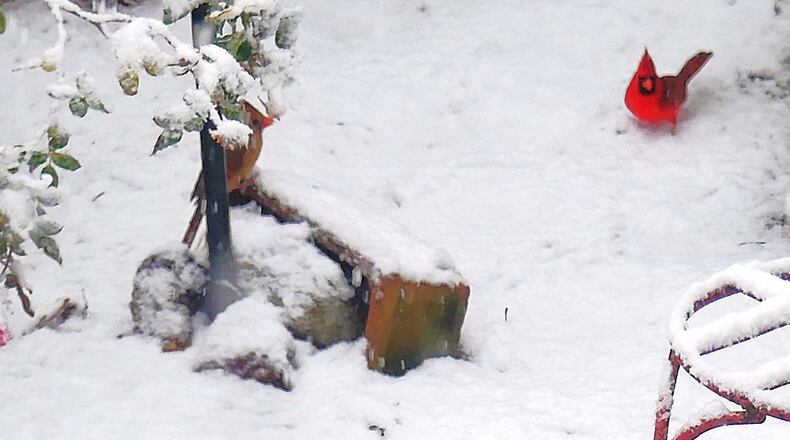On the snow day last week, I sat in my living room in Decatur and watched the white stuff drift down and gently cover the ground, trees, shrubs, garden benches and everything else outside.
Then, suddenly, a jaunty male northern cardinal landed in the snow and stayed for several seconds. His vivid red feathers seemed lit up against the backdrop of pure whiteness.
In that instant, I was in the Christmas spirit.
If the turkey is the bird of Thanksgiving, the cardinal is the bird of Christmas. No other bird symbolizes Christmas quite like the northern cardinal. With or without his mate (who is colorful in her own right), the male cardinal is often the featured species of December on bird calendars. Images of a cardinal against a snowy background seem to adorn everything this time of year, from holiday greeting cards to tree ornaments, from wrapping paper to clothing.
No one seems to know why the cardinal has become a symbol of the beauty and warmth of the holiday season. Cardinals, of course, live year-round in Georgia, and their dazzling colors add joy and sparkle to any season of the year.
Perhaps it is during the holiday season, with winter gripping the land and darkness coming early, when the sight of a radiant red cardinal — especially in the snow — is most apt to bring special cheer, hope and inspiration. That’s my view, at least.
Atlanta is likely to have at least one snowy day in mid to late winter. But last week’s heavy snow was unusual in that it came in early December, more than two weeks before Christmas.
I know that snow and ice can cause upheaval on Atlanta’s highways and shut down schools and businesses. But last week, when I saw the brilliant red cardinal in the fluffy white snow in my front yard, it was, to me, nature’s own way of saying Happy Holidays and Peace on Earth.
IN THE SKY: From David Dundee, Tellus Science Museum astronomer: Winter officially begins at 11:28 a.m. on Thursday, the shortest day of the year. The Ursid meteor shower will be visible next week, peaking at about 15 meteors per hour on Thursday night — in the east from about midnight until dawn.
The moon will be new on Monday. Mars and Jupiter — the only planets visible now — are low in the east just before sunrise.
About the Author




